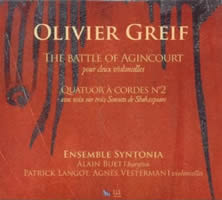Olivier Greif 1.
|
Walt Mundkowsky [November 2010.] Composer-pianist Olivier Greif (1950-2000) passed away seated at his instrument, where he was discovered days later. An autopsy failed to pinpoint the cause of death, but he had known medical crises. His mother died of cancer in 1978; in 1999 his father, a doctor and Auschwitz survivor, departed. (Most of the family had perished in the camps.) The music plumbs these areas — war, death, lament — with skill and power. Despite his obscurity, Greif attracted first-rank interpreters. (Shostakovich and Britten are often called reference points for his oeuvre, which is too neat.) The catalog on his website shows 169 entries, but many gained only a single performance or none. (The piano pieces merit more exposure.) Fluent recordings exist, largely from Triton, and more releases are coming. This Zig Zag is recent and easily found over here.
Olivier GREIF: The Battle of Agincourt (1995-96)*; String Quartet No. 2 (1998). Patrick Langot*, Agnès Vesterman* (vlc); Ensemble Syntonia: Pascal Oddon, Thibault Noally (vln), Anne-Aurore Anstett (vla), Patrick Langot (vlc); Alain Buet (bar). Zig Zag Territoires ZZT100401 (http://www.outhere-music.com/en/labels/zig-zag-territoires). Distributed in the US by Allegro Music (http://www.allegro-music.com/). Of this pair, Agincourt has more immediate appeal. Four movements suggest sonata form writ large. An opening fantasia uses the Agincourt Carol that honors the 1415 battle; with pauses following conflict, Greif keeps returning to it. The quick-stepping Chaconne spins faster as it runs, hurling sparks. With a song from the Warsaw ghetto, the third movement is the heart of things (Greif’s parents came from Poland). The Agincourt Carol is reprised for the finale’s theme and variations. Its refrains convey whirling entrapment, inspired by the wandering, doomed knight in Keats’ ballad “La Belle Dame Sans Merci.” Langot and Vesterman, cellists extraordinaire, nail the virtuosic demands and impart a swagger to the whole 31:19. String Quartet No. 2 sets deathly Shakespeare sonnets in odd-numbered movements and the composer makes few concessions to accompanying. Baritone Buet’s English is iffy as well; it took me a couple of lines to grasp what language I was hearing. The first (71, “No longer mourn for me when I am dead”) is the knottiest. Greif’s thick quartet lines lead the singer nearly into yelling, a ferocious wobble in tow. Halfway into 73, “That time of year thou mayst in me behold,” the singing has less vehemence and the close (146, “Poor soul, the centre of my sinful earth”) erases earlier outbursts with beauty. The quartet-only parts (2’s intricate tarantella, 4’s marching Intermezzo) offer no slackening of tension. Ensemble Syntonia boasts four string players plus a pianist. Greif met with them when he was getting String Quartet No. 4 performed. A 50-min. length and two weeks to prepare it didn’t make them run away screaming as some others did. That was ten years ago — he died three weeks after those recitals. Grant reviewed a 2006 Greif disc on HM here.
[More Walt Mundkowsky]
[More
Greif]
[Previous Article:
Mostly Symphonies 15.]
[Next Article:
String Theory 4: String Orchestras]
|
